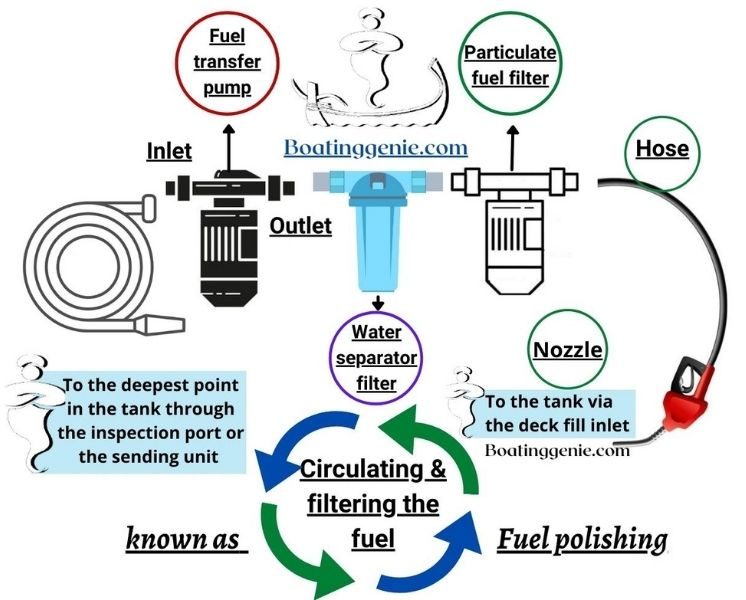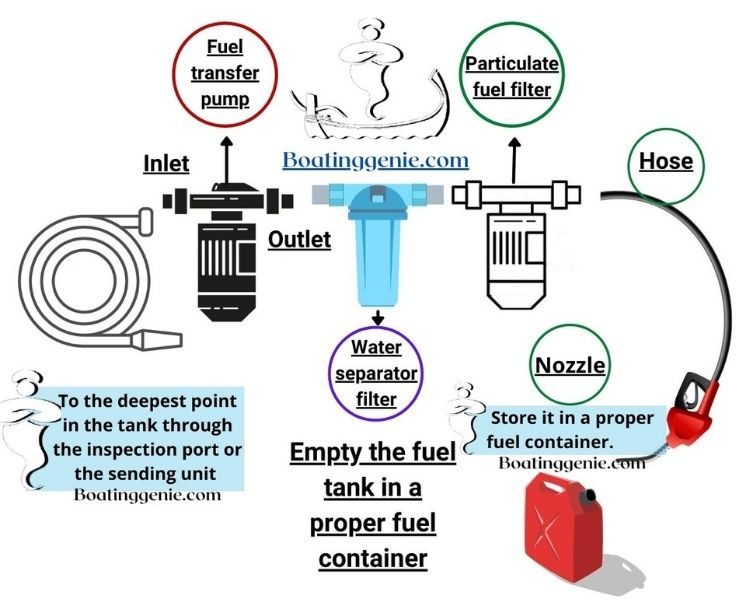How To Clean A Boat Gas-Fuel Tank? Without Removing It

Knowing that the gas-fuel tanks come in various sizes, materials, shapes, accessibility, and other details; Every tank is different.
But the following guidelines and procedures should keep you organized, and get the job done perfectly. To make the task easy I will present two ways:
Cleaning the fuel tank without removing it
Removing and cleaning the fuel tank
How to Clean The Boat Gas-Fuel Tank Without Removing It
How to Clean The Boat Fuel Tank Without Removing It?. In other words, cleaning the fuel tanks without a visual inspection of the inside of the tank.
Therefore, the cleaning of each fuel tank must be handled in a manner appropriate to the condition. This way is suited for Sailboats, Catamarans, Trimarans, Yachts, Pontoons, Fishing Boats, and Trawlers. As follows:
Constantly circulating and filtering the fuel until all dirt and sediments are extracted, then adding a biocide fuel agent for disinfection and sterilization. Pump the fuel out, run it through the water separator to the filter, then back to the tank so the fuel flows in a circle.
All you need is:
- Fuel transfer pump
- Water suction pump
- Particulate fuel filter
- Water separator filter
- Suction hose (Vinyl)
- Hose/nozzle
- Hose clamps and fitting
- Proper fuel container
- Water container
- Diesel fuel biocide
Then, follow the steps:
- Clear and prepare the work area for ease of movement.
Empty the work area of any stored items. Clear a good space around the work area. Keep the working area well ventilated. No sources of flames or sparks in the working area. More on safety procedures are below.
- Constantly circulating and filtering the fuel.
This process is called Fuel Polishing: circulating and filtering the fuel until all traces of dirt, sediment, and sludge have been removed, and water has been separated from the fuel.
- Assemble all parts as follows:
- Attach the suction hose to the inlet of the pump.
- Connect the pump outlet to the water separator filter.
- Then to the particulate fuel filter.
- Then to a hose with a nozzle to feed the fuel back to the tank via the deck fill inlet.
- Make sure to tighten the clamps well.

Insert the suction hose to the deepest point in the tank through the inspection port. (or the sending unit)
Insert the nozzle to feedback the filtered fuel to the tank via the deck fill inlet.
Connect the fuel transfer pump to the power. Make sure there are no exposed or loose connections.
Run the pump to circulate and filter the fuel. And keep an eye on the filters.
“10-20% fuel of the tank capacity is sufficient for this process.”
Move the suction hose slowly all over the bottom of the tank to extract as much of the sediment as possible.
Keep circulating and filtering the fuel until all traces of dirt, sediment, and water have been removed.
This process is not only to clean the tank but also to clean the fuel and make it usable.
When there is no dirt coming out of the fuel tank for a while, Then this means either the tank is clean of dirt and sediment, or there is dirt still stuck in the tank.
Your job might be done here but because we don’t know exactly, we will add steps to make sure that there is no dirt and sediment left inside the fuel tank.
- Empty the fuel tank in a proper fuel container.
Insert the suction hose to the deepest point in the tank through the inspection port. (or the sending unit)
Run the pump to suction fuel from the tank and store it in a proper fuel container. Ensure the fuel container capacity can take the amount of fuel in the tank.
Move the suction hose slowly all over the bottom of the tank to extract as much dirt as possible. And keep an eye on the filters. As it is in the picture.

- Detach all fuel lines connected to the tank.
Detach all fuel lines connected to the main fuel pump, ( and the second one if any), and plug and isolate them well from both sides. the tank side, the fuel pump side.
Pay attention to the fuel inside the lines. Inspect the tank for cracks, rust, or any physical damage; if there are any, the damage must be fixed.
- Wash the fuel tank with hot water and dish soap.
Yes, dish soap. Regular dish soap is an effective and inexpensive degreasing soap and will do the job perfectly in this way.
After emptying the tank of fuel, fill 10-20% of the tank capacity with soap (2 Oz-60 Ml Per Gallon) and hot water and let it soak for 15-30 minutes. Try to move or scrape the sediment at the bottom, this will help to extract it faster. then suction it out.
Run the water suction pump to suction the soap solution from the tank and store it in a proper container. Ensure the container capacity can take the amount of water in the tank.
If there is a lot of dirt coming out, then repeat. You can use a fuel tank cleaner if you are not satisfied. If there are any signs of microbial contamination in diesel fuel You need to disinfect the fuel tank from contamination.
- Wash the fuel tank with just hot water.
To extract all soap residues and make sure that there are no dirt or sediments left. After the soap is extracted the water should be clear.
You have effectively finished the fuel tank cleaning process. The fuel tank should be sparkling now. Few things left to do
- Cleaning all fuel lines and filters.
Detach all the fuel lines-hose-tubes from all sides, and connect them to the water pump outlet by clamps and fitting. Pay attention to the fuel inside the lines.
Make sure to tighten the clamps well. Then run hot soap water through them for a while. You can clean the lines with compressed air if there is not much dirt inside.
The fuel lines must be cleaned and disinfected If there are any signs of microbial contamination. Check the fuel pump filter(s). If it is cleanable, clean it, or replace it with a new one.
After cleaning the fuel lines and filters, let them air dry, then reattach them to the originally specified location.
- Reattach all fuel lines and filters.
Reattach all the fuel lines-hose-tubes from all sides, and connect them well. Make sure to tighten the clamps too. You don’t want any leakage after all your hard work.
When reaching this point, the fuel tank and the lines are clean of all dirt and sediment.
- Fill the tank with polished clean fuel.
Now the fuel tank, all lines, and filters are clean and dry and attached. Close all opened ports and fill the tank with polished fuel. Make sure to keep it as clean as possible.
Ensure the tank is completely dry before filling it with fuel. Once the fuel tank is filled with fuel, check for any leaks in case you did not tighten some clamps properly.
You can add some fuel tank cleaner or “biocidal or sterilizer” to help maintain the fuel tank clean. Your job is done. Ensure that you are going to follow the Boat fuel tank cleaning safety procedures below.
- Related Articles
The second way is removing and cleaning the fuel tank.
- Follow the steps:
- Empty the fuel tank in a proper fuel container.
- Detach all fuel lines/hoses connected to the tank.
- Then open the fuel tank following the manual.
- Clean all the dirt on the walls and sediments at the bottom (the safest way is a rag moistened with diesel fuel).
- You can use a “biocidal or sterilizer” if there are any signs of microbial contamination.
- Next, detach the fuel lines from the other side and clean them with compressed air. Then let them dry. (If there is contamination, sterilize the lines too).
- Check the fuel filter. If it is cleanable, clean it, or replace it with a new one.
- Close the tank cover and the other openings.
- Reattach the fuel lines and the work is done.
- Be sure there is no water left and the tank is completely dry before filling it with fuel.
This way may require a lot of screwing, wiping, and scraping, but it is the right way to do it.
But before starting cleaning the fuel tank, safety procedures must be performed as the primary objective first.
Boat Gas-Fuel Tanks Cleaning Safety Procedures.
- Always ventilate the working area.
- No sources of flame or sparks in the working area.
- Handle extracted fuel with caution; flammable mist can generate by excessive agitation.
- Wearing a face mask protects you from inhaling the fuel fumes.
- Protect your eyes with proper eye protection. and always wear hand gloves.
- Do not cause much heat to an empty fuel tank; which can generate enough fumes to cause a fire or explosion.
- Any operating electrical appliances should not be placed in an enclosed space as vapors can build up.
- Or turn it off before starting and not turn it on until the work is done to avoid triggering any sparks.
Boat Gas-Fuel Tanks Cleaning Tips And Notes
- If there isn’t much dirt and sediment coming out with the fuel, probably the fuel tank doesn’t need attention yet.
- When connecting the fuel lines-hose-tubes to the pump outlet the fuel could come out stronger and faster because the hoses may have a smaller diameter.” Be aware of that.”
- This is a good opportunity to check whether some parts need replacement or maintenance and that all parts are working properly.
- You still need to disinfect the fuel tank from contamination (microbes, bacteria, and fungus) if there are any signs of microbial contamination in diesel fuel.
- Likely there are if you don’t perform a regular fuel tank cleaning. (you can tell from the dirt that you got).
- Fuel polishing will not solve the problem In a badly infected tank. Though, for a closed fixed fuel tank you do not have many options.
- Determined by the nature and kind of the infection, the feasible choice is to use fuel biocides appropriate to the nature and kind/type of infection. And follow their instructions from thereon.
Be aware All biocidal must be registered with the U.S. Environmental Protection Agency (EPA).
- keeping the fuel tank full as much as possible will minimize if not prevent the possibility of fuel contamination occurring.
- Microorganisms and contaminants grow in diesel fuel if there is water and air present.
- One more proactive approach is consuming clean fuel in the first place. So that fewer contaminants and sediments build up.
- Clean the fuel tank before any long-term storage. This will prevent sludge hardening and contamination from spreading.
- Fuel tank cleaning should be on the main regular maintenance checklist.
- Always check the fuel tank and the fuel itself regularly at least once a one-two month if possible, with a visual inspection or by contamination test.
- “The use of a shop vacuum is dangerous and has been linked to several fires”
One of the essential regular tasks is cleaning the fuel tank. Because it directly affects the entire fuel system and also the engine’s power and torque.
Moreover, it shortens the service life of some parts such as fuel filters, fuel pumps, carburetors, and others.
Therefore, you must make sure that your fuel tank is always clean, and will you clean them if there are more than one signs that indicate the need to clean the fuel tank, such as clogged filters, jammed turbine pump, carburetors get clogged, reduced fuel flow, engine sputtering on starting, etc.
Related Questions
How Often Should You Clean The Boat’s Gas-Fuel Tank?
You should clean the boat’s fuel tank at least once every two years. Or after a longer storage time than usual. Or if there are signs that a cleaning procedure is needed, such as Sputtering Engines, Jammed Pump’s Turbine, Clogged Carburetors – Filters, Low Fuel Flow, or visual inspection.
Cleaning the boat fuel tank annually would be better.
I hope this guide was helpful. Bookmark this page to remember and come back to it whenever you need it. Share this post to help someone else.